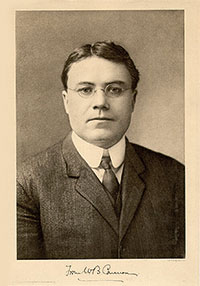
Walter Cannon (1871-1945), physiologist and professor at Harvard University, is a paradigmatic example, not only for his remarkable work on experimental scientific research and conceptualisation, but also for his civic engagement and international political activism.
As a young researcher at Harvard University, Cannon felt attracted towards research on the physiology of emotions, and, between 1897 and 1911, he worked on this domain. He discovered that emotions trigger not only the autonomic nervous system, but also adrenaline, causing a fight or flight emergency response. He summarised his initial findings in a groundbreaking book entitled Bodily Changes in Pain, Hunger, Fear and Rage (1915).
In 1917 and 1918, Cannon joined the US Army in the Great War. In various laboratories and hospitals in England and France he did some field work on traumatic shock and the concatenation of events that cause it. After the war, he returned to Harvard and focused on finding out the complexity of chemical neurotransmission, and proposed the concept of homeostasis (1926), the key to understanding organic regulation. His findings laid the foundations for the concept of integration and opened the door to psychosomatic medicine.
But Cannon also became an important public figure in the domain of politics and international activism. He knew firsthand the threat of fascism in Europe and kept a close scientific and personal relationship with French, British and German researchers, as well as with Juan Negrín, whom he met in Leipzig when our physiologist was a young PhD student at the Institute for Physiology of the city. In 1916 Negrín applied for a grant to the Council for the Extension of Studies and Scientific Research in order to be able to work in Harvard with Cannon for two years, but Ramón y Cajal offered him to lead a new experimental physiology laboratory created specifically for him within the premises of the Student Halls of Residence.
«During World War I, Cannon did some field work on traumatic shock and the concatenation of events that cause it»
Walter Cannon was aware of the terrible tragedy that threatened democracy, the values of freedom of the Second Spanish Republic, and the relationship of the 1936 military coup with the growth of fascism at an international level. This is why he was deeply involved in several organizations that supported refugee scientists who fled Germany and also why he chaired the American Medical Bureau for the Aid to Spanish Democracy, and the American-Soviet Medical Society. Contrary to the growing paranoid anticommunism of American conservatism, Cannon, Negrín and many others defended the social engagement of science and never took authoritarian or anti-democratic positions. Along with Edward Barsky and many other physicians who were actively involved in the Lincoln Brigade during the Spanish Civil War, just like Quaker, Baptist and other associations that questioned American-neutrality in the conflict did, Cannon embodies the figure of the honorable scientist not only in relation to his contribution to science, but also due to his contribution to increase the dignity of the human race.





